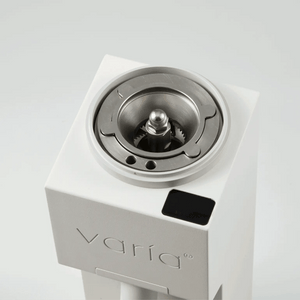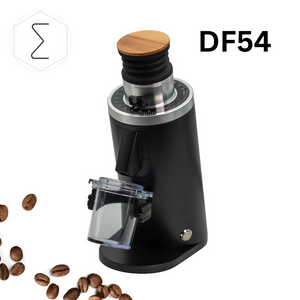A common question we receive multiple times a week is just that, how do I choose my grinder. 1Zpresso (pronounced EZ presso) doesn't make it particularly straight forward with their naming convention, but we hope this guide makes it easier for you to decide.
My personal answer has always been roughly the same; it depends what you are looking for in a grinder. Are you looking for a daily workhorse that will produce great grinds across the range, or are you looking for that one grinder that focusses on minimising the production of fines in your V60? Or maybe you value ease of use, perhaps portability? All of these factors will be broken down for you below.
1Zpresso Range
Broadly, we would classify the grinders into the following 'suitability':
Filter - J, K-Ultra*, ZP6
Espresso- J-Ultra
Hybrid / All-purpose - K-Ultra*, X-Ultra, Q, Q-air
* - The K-Ultra is what I would describe a filter-leaning hybrid.
Now when we say filter, we of course mean all of the percolation methods in the V60, Chemex and Electric Percolator (otherwise known as batch brewers), but also the hybrid immersion-percolation brewers such as the Aeropress, Clever dripper and the Hario Switch. What we really mean is that the grinder focusses on minimising fines production, that's what the burr is designed for.
You may then also want to classify the grinders further into ease of use and grind chamber size / capacity
| Bottom internal adjustment dial | Q, Q-air, J |
| Top external adjustment ring | J-Ultra, X-Ultra, K-Ultra, ZP6 |

Example of top adjustment ring - K-Ultra
Grind chamber capacity
| Q, Q-air | 15-20g |
| X-Ultra | 25-30g |
| J, ZP6 | 28-35g |
| J-Ultra, K-Ultra | 35-40g |
It should hopefully be becoming clearer what grinder you are honing in on. Espresso focussed? J-Ultra. Filter mad? Try the J or the ZP6
Filter lovers, in increasing clarity: Q < J <= X-Ultra < K-Ultra < ZP6
Espresso lovers, in increasing body: ZP6 < Q < K-Ultra <= X-Ultra < J-Ultra
What if I want a 1Zpresso grinder that can do everything for under £150? Simple, I would point you to the X-Ultra in a heartbeat. It pulls the best of both worlds and gives you a larger grind chamber and a top internal adjustment - a grinder that will last years and combines extreme utility with fantastic design and at a price that is pretty respectable. If budget is not a question, the K-Ultra wins.
So what about the Q series? The Q series is split into two, the Q-air and the Q. They are both portable grinders which produces great grind consistency in the filter range. The Q can, and will, produce espresso fine grinds to a high standard it just may take a little more effort owing it its slightly smaller 40mm burr set. It is the entry level model in the range that tries to fit the bill for everybody, but it fits filter more than espresso. The only difference between the Q and Q-air is the body composition, the Q-air has a durable plastic body whereas the Q has the more conventional aluminium alloy body.

1Zpresso Q Manual Coffee Grinder
Nerdy stats for burr adjustment gaps in the range
| Grinder | Total adjustments or clicks | Burr set | Microns ( µm) per click |
| Q | 90 | 40mm | 25 |
| J | 120 | 48mm | 25 |
| ZP6 | 90 | 48mm | 22 |
| J-Ultra | 500 | 48mm Ti-Coated | 8.0 |
| X-Ultra | 240 | 40mm | 12.5 |
| K-Ultra | 120 | 48mm | 20 |
While the statistics above can be interesting to look at, all you need to know is more adjustability gives you more flexibility in curating the grind size you want. However, it doesn't tell you how well it produces that grind size, or rather what sort of distribution you get and the production of fines. That's where you need to look at the burr set, both in size and in geometry.
At the end of the day, use the facts above to inform your own decision-making, but know that the grinders and their burr sets have been either been designed to target a specific brew method, or have been designed to give a hybrid approach. Each grinder will have a characteristic profile too; even though the J and the K-Ultra are both filter leaning grinders, they will still taste different and have their own characteristics, that's just the nature of the grinder.
The final remark I would make is this. Let's be clear about the fact that categorising grinders into discrete specialties does not discount it from being able to be used for any brew method. All the grinders above will produce grind sizes between espresso and filter. However, using the J-Ultra for filter may not produce the right results due to the amount of fines it will produce in the coarser regime.
An aside for intermediate/seasoned coffee lovers:
Dare to think outside the coffee-box. This guide certainly isn't saying "this grinder is only for filter" or "that grinder is only for espresso". What we are describing is that it is easiest to brew filter with this grinder, reliably - because the grinder has been set up in that way and vice versa.
But if you wanted to pull espresso shots with a ZP6, that's completely doable despite our guide saying its a 'filter grinder' - it would just require an understanding that you will need to grind extremely fine, possibly at near burr touch (owing to the minimal fines produced). What results is an interesting light bodied floral shot. But you have to work to get that shot. And do you want to be doing that every day? Maybe not, but some coffee lovers would like the idea that they could if they wanted to?
Once you're seasoned with how to adjust all the parameters of extraction, and you fully understand the part 'fines' play in extraction in both filter and espresso, you can use any grinder and unleash its full potential. You will begin to understand the nuances between each grinder for each brew method, rather than boxing this grinder for that brew method.

